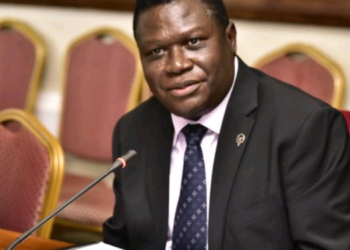By Najib Mulema
Dfcu Bank has asked its Managing Director Juma Kisaame to rescind his decision to leave the institution at the end of his contract that is due to expire in December.
The bank, under Kisaame took over Crane Bank in a deal which made it the second largest bank in the country bank by assets. But the controversy surrounding its acquisition has since painted a picture of an institution with serious corporate governance concerns.
“Mr Kisaame is likely to decide to leave at the end of his contract but we have failed to get a suitable person to take over because people are not willing to work with us at the moment because of what the bank is going through,” a source at Dfcu told Watchdog.
Currently, the bank’s board led by city lawyer Elly Karuhanga is working around the clock to ensure that Kisaame renews his contract so that he cleans up the mess under scrutiny that came in place under his leadership.
In January 2017, Bank of Uganda sold Crane Bank to Dfcu in a secret deal which only revealed a buyout of Shs200 billion when the bank had assets in the excess of a trillion shilling.
The deal, however, was sealed against basic business practice, including excluding the shareholders of Crane bank. It later emerged Dfcu was continuing to pay Bank of Uganda money after loan collection which was part of the unwritten deal.
Last month, Auditor General John Muwanga punched holes in Bank of Uganda’s sale of Crane Bank.
He said the Purchase of Assets and Assumption of Liabilities (P&A) deal Bank of Uganda officials signed with Dfcu on January 25, 2017 for the purchase of Crane Bank Limited, formerly owned by tycoon Sudhir Ruparelia and others, didn’t follow the right procedures.
“I was not provided with the negotiation minutes leading to the P&A agreement. In the absence of the minutes, I could not determine how Bank of Uganda selected the best evaluated bidder and how the terms in P& A were determined,” the report adds.
When it came to the valuation of assets and liabilities of Crane Bank before the Dfcu takeover of the bank at Shs200 billion, the AG said, “On April 10, 2018, I requested for P&A agreement, including details of the assets and liabilities transferred after taking into account the requisite valuation. I noted that BoU did not carry out a valuation of the assets and liabilities of CBL. In the absence of the valuation, I could not establish how the terms for the transfer of assets and liabilities in the P&A were determined.”
In a meeting with the Bank of Uganda’s outgoing executive director of supervision, Justine Bagyenda held on June 13, 2018, at Bank of Uganda offices, the directors admitted that the Bank of Uganda did not carry out a valuation of the Crane Bank assets and liabilities but relied on inventory report and the due diligence undertaken by Dfcu to arrive at P&A agreement.
“I also noted that the P&A did not have complete details of assets and liabilities transferred to dfcu with their corresponding values; I was therefore, unable to establish the status of assets and liabilities transferred to Dfcu.”
The AG, however, says BoU officials gave him a soft copy of details of assets and liabilities although the information lacked details of loans and advances transferred to Dfcu and evidence of valuation of assets before sale hence it was insufficient to respond to his observation..
It should be remembered that after Bank of Uganda announced that it has transferred Crane Bank equity into Dfcu, later in the year, Dfcu announced its biggest profit margin in history. The bank was also propelled to number two in Uganda. However the successes soon turned sour with former Crane Bank managers challenged the sale.
The AG report also puts Kisaame’s name in a rather compromising position as he is said to have taken a central role in the negotiations for Crane Bank.
Do you have a story in your community or an opinion to share with us: Email us at editorial@watchdoguganda.com











